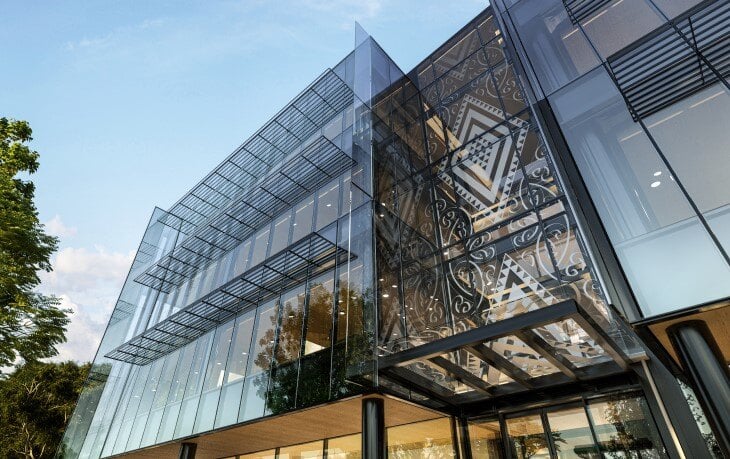02 September 2021
In the latest version of Homestar we have made a few key changes to support our building industry to deliver the homes that Kiwis deserve, Aotearoa needs, and that climate action demands. One of the biggest is the increased emphasis on embodied carbon.
Embodied carbon: what is it?
Outside of academia and sustainability circles this term is not well understood. Even among the experts, embodied carbon is often at the bottom of the iceberg when it comes to analysing our impact on the plant. So, what is it?
Take a building material, let's use a brick as an example. In order to create that brick you need to dig out the appropriate soil, transport it to a plant, compact it and mould it into shape, dry it in a kiln, then transport it to a supplier’s yard. All that happens before it's finally delivered it to a construction site where it is used in the build. All of these steps have associated carbon emissions. Embodied carbon through that stage of its life is refered to as 'cradle to gate'.
From EN15978: 2011, Sustainability of construction works. Assessment of environmental performance of buildings. Calculation method
As you can see from the diagram above, emissions associated with materials continues long after reaching site. There are emissions through construction itself as well as ongoing maintenance. While brick is popular for being low maintenance, others materials such as painted weatherboards may need a bit more attention such as more frequent cleaning, repainting or repair from damage by the elements. Finally, at some point the house will reach the end of its life and be demolished. There are obvious emissions associated with demolition and disposal of waste.
If you consider a material from its raw state through to demolition that's called a cradle-to-grave assessment. If that material can then be upcycled or reused we can go one step further to a cradle-to-cradle assessment. This is very simplistic of course, as cradle-to-cradle conceptually means a lot more, but that’s another article for another day. All of this can get quite complex and overwhelming, with many nuances that affect accuracy and comparability. For example, where do you draw the line in terms of scope? Cradle to gate or cradle to grave? How do you determine the transport emissions of that brick through different supply chains? Or if it it's ending up in Whangārei or Invercargill?
With those challenges it's not surprising accurate embodied carbon calculation has been untouched by many until recently. But the time is now, we must start to embed these considerations as the need for climate action becomes more urgent. The good news is there are two game changers.
Environmental Product Declarations
Firstly, with the use third party verified Environmental Product Declarations (EPDs) growing, more and more manufacturers are making the carbon footprint of their products transparent across the product value chain. Some industry-wide EPDs are now available where individual manufacturers do not have their own EPDs. The fact these are third party verified to an international standard helps consistency and comparability. We're working to incentivise manufacturers to do EPDs by rewarding projects that use products with EPDs through our certifications.
The new Homestar Embodied Carbon Calculator
You can’t always access an EPD for every single product and even if you do find one, what do you do with it? The second recent game changer is access to life cycle carbon assessment tools that use EPD and other data. This is where we come in.
The Homestar Embodied Carbon Calculator (HECC) is a tool that BRANZ has developed for NZGBC to make life cycle embodied carbon assessments accessible to everyone. Homestar V5 requires calculation of embodied carbon emissions from 1st July 2023.
HECC is Excel based and easy to use, allowing cradle-to-cradle life cycle embodied carbon assessments of homes with traditional constructions (e.g. timber/steel framed homes). We’re making it freely available to everyone. If a home is built with materials that are not quite standard in New Zealand yet, a more detailed assessment can be carried out using LCA Quick, a free tool developed by BRANZ (available on their website). While there are limitations, these entry level tools make assessments easily available to the market, and allow industry to start considering embodied carbon as standard practice. We will keep progressing from here.
Buildings
Clients are increasingly interested in embodied carbon. Government guidance from the Government Property Group has set out that Government Departments should be asking about embodied and operational carbon on new build projects. Embodied carbon emissions can be calculated through Green Star at present. Anybody wanting to evidence that their buildings is lower embodied carbon can use the Life Cycle Analysis credits. The B201 project that Auckland University undertook is a good example. Credits were achieved for low embodied carbon performance through re using the existing structure and then using lower embodied carbon materials such as timber.
In New Zealand there is not agreement on how embodied carbon is measured for buildings. The NZGBC is developing a common methodology for accounting for embodied carbon in buildings. We aim to consult with the sector on this before end of this year. Watch this space.
Legislation has been introduced by Government to call for mandatory financial climate disclosures. Following passage in Parliament, major banks, insurers and financial institutions that fund the building industry would be obligated to start disclosing climate-related information as soon as 2023. Now is your opportunity to get ahead and be prepared.



